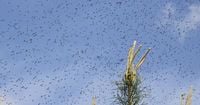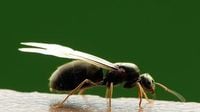As summer 2025 unfolds, Brits are bracing for what experts predict could be one of the most spectacular—and swarming—Flying Ant Days in recent memory. This annual natural event, when millions of winged male and female ants take to the skies in search of mates, is expected to be larger and more widespread than usual, thanks to a unique combination of weather conditions that have created a perfect environment for these tiny insects to multiply and take flight.
Flying Ant Day is not a single fixed date, despite what the name might suggest. Instead, it unfolds over several weeks during the warmer months of July and August, varying across regions depending on local weather patterns. This year, however, experts are sounding the alarm earlier than usual. According to predictions from Best Ants UK, peak flying ant activity is expected around July 22 to July 25, with urban areas likely to see swarms sooner due to their typically warmer microclimates.
Paul Blackhurst, Head of the Technical Academy at Rentokil Pest Control, has been closely monitoring the phenomenon. He warns that “this year could see larger-than-usual swarms of flying ants, as we approach Flying Ant Day, also known as the nuptial flight, and sometimes nicknamed ‘flant day.’” Blackhurst explains that the alternating wet and warm weather patterns experienced this summer have created ideal conditions for swarming. “Humidity is important in keeping the ants’ wings and bodies moist during flight and ‘mating on the wing,’” he said. “The perfect storm of weather has set the stage for what could be one of the most prolific years in recent memory.”
Indeed, the combination of recent rainfall followed by warm spells has elevated humidity levels, which is crucial for the ants’ ability to stay airborne and successfully complete their mating ritual. In fact, radar systems have historically mistaken these dense clouds of ants for rain, underscoring just how thick and widespread the swarms can become.
But why do these ants take to the skies en masse? The answer lies in their reproductive strategy. The winged ants, known as alates, emerge from their colonies to mate mid-air. This synchronized flight serves to overwhelm predators such as swifts and gulls, increasing the chance that enough ants survive to establish new colonies. After mating, the smaller male ants quickly fall to the ground and die, while the fertilized female queens shed their wings and burrow into the soil to start new colonies, laying the groundwork for thousands of future ants.
Beyond the spectacle and occasional annoyance—picnics and pub garden pints beware—these flying ants play a vital role in the ecosystem. Their tunneling aerates the soil, enhancing its quality and nutrient recycling. Additionally, the swarms provide an essential food source for many bird species. There’s even a fascinating mutualistic relationship between certain ant species, like the black garden ant and the cornfield ant, and the silver-studded blue butterfly. The ants tend to the butterfly caterpillars, feeding on secretions, while protecting the caterpillars from predators, highlighting the interconnectedness of nature’s web.
For those concerned about keeping these winged visitors out of their homes, pest control experts offer practical advice. Rentokil recommends sealing cracks around doors, windows, and pipework to block entry points. Keeping windows and doors shut or installing fly screens can prevent flying ants from entering while still allowing fresh air inside. Additionally, maintaining cleanliness by sweeping up food debris, storing food in airtight containers, and ensuring rubbish bins have tightly sealed lids can reduce the attraction for foraging ants.
For a non-toxic home remedy, experts have highlighted the effectiveness of ground cinnamon, an affordable and natural deterrent. Nicole Carpenter, President of Black Pest Prevention, explains that while cinnamon doesn’t kill ants, its strong scent creates an unfavorable environment that encourages ants to leave. Sprinkling ground cinnamon along entry points or placing cinnamon sticks near problem areas can act as a barrier. For a less messy option, a spray made from cinnamon essential oil mixed with water and vodka can be applied to affected areas, disrupting the ants’ pheromone trails that guide them to food sources.
While the sight of millions of flying ants may disrupt summer plans, it’s worth remembering the bigger picture. Their swarming is a marvel of natural engineering, a reproductive spectacle that ensures the survival of their species and supports broader ecological health. Paul Blackhurst sums it up well: “While flying ants might disrupt your picnic, barbecue, or pub garden pint, they play a vital role in the ecosystem by aerating soil, recycling nutrients, and serving as a key food source for birds.”
So, as the skies fill with these tiny winged creatures this summer, instead of swatting them away in frustration, consider the intricate dance of nature playing out above. It’s a reminder of the delicate balance sustaining our environment, where even the smallest creatures have a huge part to play.


